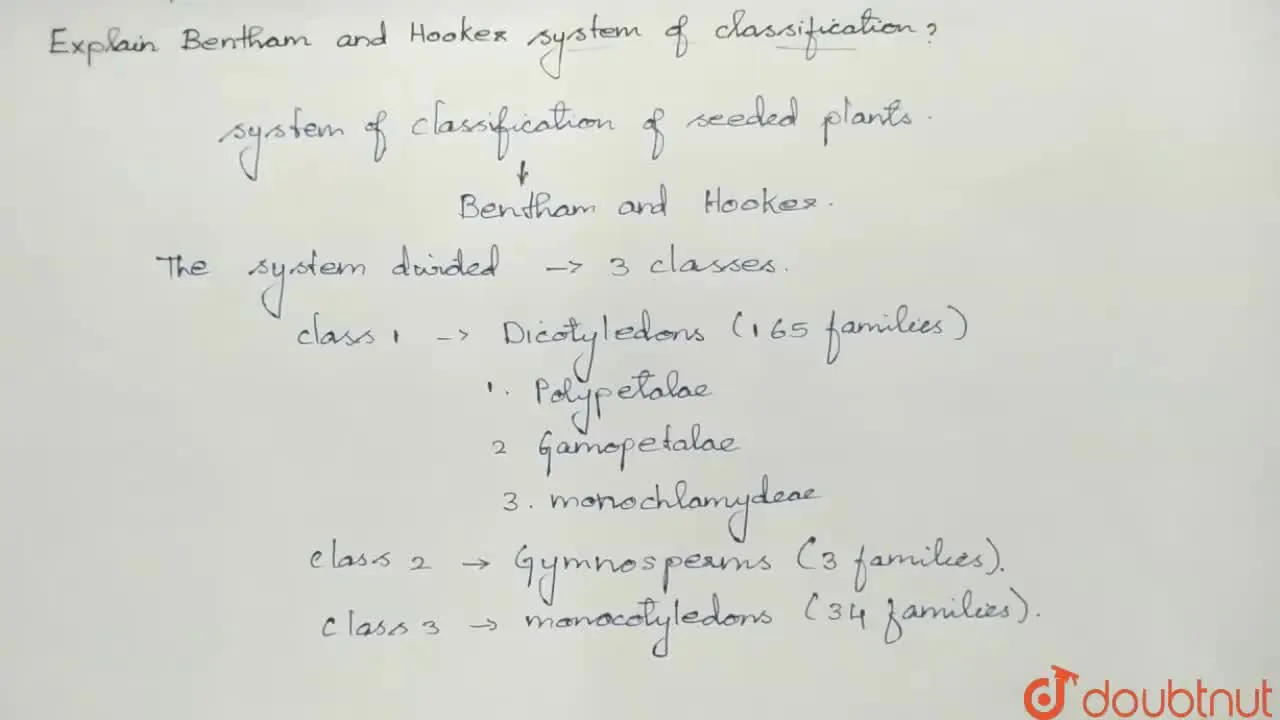Explain Bentham and Hooker system of classification? Solution in Tamil
Video Solution
Text Solution
A widely followed natural system of classification considered the best was proposed by two English botanist George Bentham ( 1800 - 1884) and Joseph Dalton Hooker (1817 - 1911).
They described 202 families and 7569 genera and 97, 205 species. In this system, the seeded plants were classified into 3 major classes:
Class I Dicotyledonae:
Plants contain two cotyledons in their seed, leaves with reticulate venation, tap root system and tetramerous or pentamerous flowers come under this class. It includes three sub-classes - Polypetalae, Gamopetalae and onochlamydeae.
Sub-class l. Polypetalae:
Free petals and dichlamydeous flowers. It is further divided into three series - Thalamiflorae, Disciflorae and Calyciflorae.
Series (i) Thalamiflorae:
Flowers with dome or conical shaped thalamus and superior ovary. It includes 6 orders and 34 families.
Series (ii)
Prominent disc shaped thalamus with superior ovary. lt includes 4 orders and 23 families.
Series (iii)
Flowers with cup shaped thalamus and with inferior or sometimes with half inferior ovary. Calyciflorae includes 5 orders and 27 families.
Sub-class 2 . Gamopetalae :
United petals. which are either partially or completely tused to one another and dichlamydeous. It is further divided into three series - Inferae, Heteromerae and Bicarpellatae.
Series (i) Inferae : The flowers are epigynous and with inferior ovary. lnferae includes 3 orders and 9 families.
Series (ii) The flowers are hypogynous, superior ovary and with more than two carpels. Heteromerae includes 3 orders and 12 families.
Series (iii) The flowers are hypogynous, superior ovary and with two carpels. Bicarpellatae includes 4 orders and 24 famiIies.
Sub-class 3. Monochlamydeace :
Incomplete flowers either apetalous or with undifferentiated calyx and corolla are placed under monochlamydeae. The sepals and petals are not distinguished and they are called perianth. Sometimes both the whorls are absent. Monochlamydeae includes 8 series and 36 families.
Class II Gymnospermae :
Plants that contain naked seeds come under this class. Gymnospermae includes three families - Gnetaceae, Coniferae and Cycadaceae.
Class III Monocotyledonae:
Plants contain only one cotyledon m their seed, leaves with parallel venation, fibrous root system and trimerous flowers come under this class. The Monocotyledonae has 7 series and 34 families.
Merits : (i) Description of plants is quite accurate and reliable, because it is mainly based on personal studies from actual specimens and not mere comparisons of known facts.
(ii) As it is easy to follow, it is used as a key for the identification of plants in several herbaria of the world.
Though it is a natural system, this system was not intended to be phylogenetic.

|
Updated on:21/07/2023
Similar Questions
बेंथम व हुकर के वर्गीकरण का प्रमुख गुण क्या है
02:26View SolutionBiological classification - Aristotle | | Theophrastus | | Linnaeus | | Bentham and Hooker
50:47View SolutionBentham and Hooker proposed their system of classification in
00:53View Solutionबेंथम तथा हूकर ने पुष्पी पादपों का वर्गीकरण दिया है। यह वर्गीकरण प्रणाली कैसी थी?
04:03View SolutionBentham and Hooker have given the classification of flowering plants. This classification system was
01:26View Solutionबैन्थम एवं हुकर द्वारा दिया गया वर्गीकरण किस पद्धति से सम्बन्धित है?
01:47View SolutionIn which book Bentham and Hooker proposed their classification?
01:44View SolutionClassification given by Bentham and Hooker is
01:27View Solution


